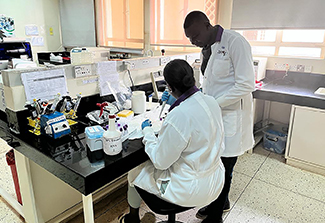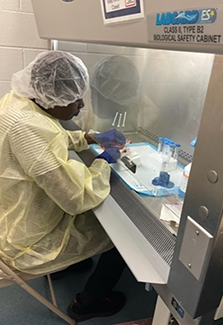Profiling the lung microbiome to fight COPD in Uganda
July/August 2023 | Volume 22 Number 4
 Photo courtesy of Alex KayongoDr. Alex Kayongo (standing) consults with a colleague in his laboratory. Kayongo continues to decipher the lung microbiome to better understand how immune responses in people living with HIV and COPD.
Photo courtesy of Alex KayongoDr. Alex Kayongo (standing) consults with a colleague in his laboratory. Kayongo continues to decipher the lung microbiome to better understand how immune responses in people living with HIV and COPD.
Attempting a bold new idea—a scientific first—can inspire a young researcher. Dr. Alex Kayongo, a Fogarty-trained investigator, is using bronchoscopies to examine the lung microbiome of Ugandans living with HIV and chronic obstructive pulmonary disease (COPD). His work at the intersection of these diseases is unique and so is his approach to understanding disease phenotypes.
COPD, an inflammation of the lungs that causes wheezing, cough and difficulty breathing, has grown more common among people living with HIV as widespread use of antiretroviral therapy has increased longevity. In rural Ugandan clinics, COPD prevalence is estimated at approximately 6%. “We didn't find significant differences in the prevalence of COPD in patients with HIV versus those without, but there was something peculiar about the association of HIV with COPD,” said Kayongo, an immunology fellow at Makerere and Rutgers universities. The difference: Severe COPD is much more common among people living with HIV.
Reasons why this is the case might lie in the bacterial communities that inhabit patients’ airways, thought Kayongo. A simple study profiling these microbes showed unique microbial populations and microbial density in the individuals with both diseases. This prompted Kayongo to identify the core microbiome composition to understand whether “bystander” organisms might be the drivers of inflammation in individuals with COPD.
A mentor pushes for progress
“I initially thought of examining expectorated sputum, but decided this may not be representative of the distal airway — the main site of airflow obstruction in COPD — since it could be contaminated with organisms inhabiting the oral cavity,” said Kayongo. Instead, he chose a semi-invasive procedure called sputum induction, where a patient inhales nebulized saline solution (a mist), which liquifies airway secretions, and promotes coughing and expectoration. “It was a prerequisite for us to put in place a negative pressure environment, so these procedures were safe and would not transmit infectious pathogens, like TB, to those doing the inductions or to other patients.” Based on this work, Kayongo created a profile for each patient’s microbiome and immunity, yet his mentor, Dr. Trishul Siddharthan suggested he use bronchoscopy to look at the distal airways. Kayongo wondered how that could be done.
After conducting an ethical review and gaining clearance, Kayongo enlisted the help of the bronchoscopy team at Makerere , Professor William Worodria and Dr. Rejani Lalitha Kumari. They agreed to conduct the delicate procedure, which involves passing a fiber optic tube through the mouth or nose into a lung airway, introducing a sterile saline solution, and collecting fluid for analysis. Kayongo, himself, had the necessary training to perform the in-depth lab work and analysis.
Sadly, an Ebola outbreak interrupted his progress in September 2022. “We delayed recruitment until February 2023, when Uganda was declared Ebola-free. We started our first procedure later that month. To date, we've performed about 40 bronchoscopies,” he said.
 Photo courtesy of Alex KayongoDr. Alex Kayongo works in the lab analyzing samples.
Photo courtesy of Alex KayongoDr. Alex Kayongo works in the lab analyzing samples.
Personal development and institutional growth
His lab has already published three manuscripts and, as part of the project, he’s mentoring three research fellows in microbial immunology. "Dr. Kayongo's first independent grant was in the
HIV-associated NCD program, which urges new collaborations in new research areas. His work has clearly demonstrated the program's success," said Dr. Geetha Bansal, program director for Fogarty's HIV Research and Training Programs.
“Currently, I’m the lead of the lung infection and immunity working group at Makerere University Lung Institute, established in 2015,” said Kayongo. “Its mission is to conduct high quality lung health research that integrates disease prevention, clinical care, as well as training in sub-Saharan Africa.” The lung institute has nine working groups, which have active projects that are generating good preliminary data while influencing policy within Uganda as well as Africa at large, he noted.
As Kayongo continues to decipher the microbiome code in the context of host immune responses, the institute where he works is poised to grow.
“There are some limitations that we face in Africa but through collaboration with Fogarty and the U.S., we've been able to get training as well as gain access to high-end technologies. My mentors, as well as my colleagues based locally and in the U.S., Germany and the UK, have been critical in making sure I do robust and rigorous research on the continent.”
More information
Updated: August 14, 2023
To view Adobe PDF files,
download current, free accessible plug-ins from Adobe's website.
Related Fogarty Programs
Related World Regions / Countries
Related Global Health Research Topics